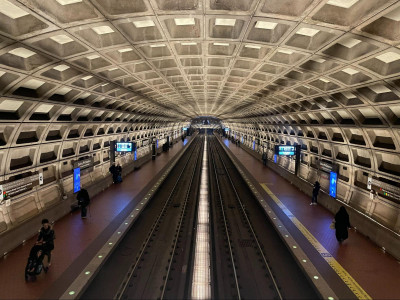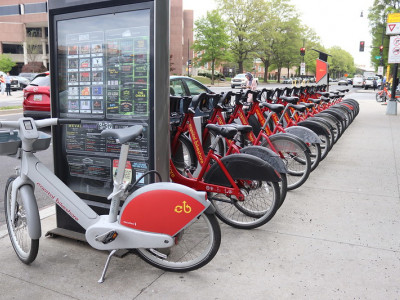The future of Union Station includes new destinations

The future looks bright for Washington Union Station Image by Ted Eytan on Flickr licensed under Creative Commons.
Union Station has connected Washington to the nation's rail grid since 1907. Now the busiest station in the US outside of New York City, its dated facilities struggle to keep pace with the growing tide of railway travel. Fortunately, a multi-billion dollar rejuvenation has begun at the facility, which ought to see its completion around the end of the next decade. Here is a video tour of the plans. Though the historic headhouse will remain largely in tact, the station will receive a total makeover, modernizing every aspect of the intermodal center, improving connectivity, flow, and passenger experience. And if American railways continue along their current trajectory, passengers at this beautiful station will have access to a cornucopia of new destinations from Union Station by the time the upgrades are completed.
Though this article will primarily focus on mainline rail destinations, the station remodel will include enhanced bus facilities, nearly tripling the number of bus slips which concievably will attract more commuter and intercity bus service to Union Station. The DC Streetcar will get improved connectivity, and by then may likely have extensions to new destinations like Georgetown and Benning Road Station. And most of the preferred alternatives for Metro's next wave of major expansion bring another Metro line to Union Station. But Union Station exists for the railroads, and by 2040 their reach could take passengers to scores of new cities on one-seat rides from DC.
Commuter Rail
Currently, five commuter rail lines terminate at Union Station serving commuters from Maryland, Virginia, and West Virginia. Both MARC and VRE have plans on the books for service increases and potential extensions to their networks. Some of these extensions would plug DC into a much larger network of commuter rail systems in the Northeast. If the Greater Washington Partnership's vision becomes reality, MARC and VRE could combine into an all-day, bi-directional through-running system with headways as frequent as every 15 minutes for much of the system. Once Union Station's renovations have completed, the commuter rail that serves it could have drastically better utility and reach several new destinations.
MARC Brunswick Line alternatives under study by Maryland Transportation Authority.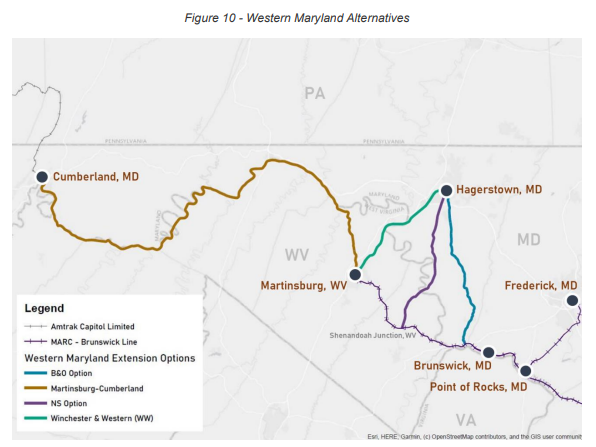
Despite financial and political setbacks, MARC has maintained ambitions to bring new destinations into the network. The MARC Growth and Transformation Plan outlines new expansion on all three lines of the system. The Brunswick Line, serving Montgomery County and points west, has several improvements undergoing studies that would speed trains, increase frequencies, and new extensions. Currently the line runs services that terminate as far afield as Frederick and Martinsburg. By 2040, a new branch could possibly connect passengers to Hagerstown while another extension could bring trains past Martinsburg to Hancock and Cumberland. The upgrades will also bring these destinations reverse peak, midday, and weekend service if the Brunswick Line Study becomes fully realized.
Two more states should enter MARC's reach by 2040 as well. The MARC Growth and Transformation Plan outlines expansions first discussed as early as 2007 and most recently in their 2019 Cornerstone Plan. Penn Line extensions look to bring service to Elkton and then into Delaware, terminating at either Newark or Wilmington. This will connect MARC to Philadelphia's SEPTA commuter rail network, bringing a low cost option for reaching destinations in southestern Pennsylvania. Additionally, both MARC and VRE will likely benefit from the Long Bridge expansion project, doubling railway capacity across the Potomac River. MARC plans to capitalize on the new capacity by running trains through Union Station to Alexandria, while VRE will have an opportunity to run more service on its two existing lines.
As for VRE, the only new destinations discussed recently are Gainesville and Haymarket on a proposed branch of the Manassas Line. These plans have stalled, but with the state of Virginia's aggressive rail expansion over recent years coupled with the new capacity of a renovated Long Bridge and an ever-growing population, it's possible that by 2040 that extension could come to fruition. Even if no new stations come to the VRE network in the future, a new amenity will come to VRE if Manassas Regional Airport realizes plans to offer commercial flights, which could happen in the next couple years. Riders from inside the Beltway could catch flights using the Manassas Line's Broad Run station, which sits adjacent to what might become Washington's fourth commercial airport.
A Rail Revolution Brings the Promise of New Connections on Amtrak
As Amtrak's second busiest station, Union Station already enjoys direct connections to most major cities on the East Coast, as well as several points west. More destinations will open up as the nation sees the windfall of the 2021 Bi-Partisan Infrastructure Law which established funding streams for intercity passenger rail, among other investments. Released shortly after the passage of that law, the Amtrak Connects Us vision projected a series of state-sponsored and regional rail corridors, mostly medium distance lines with multiple daily connections. It proposed 39 new and 25 improved routes. The vision doubled the number of state-sponsored Amtrak routes, adding stations in 160 new locations.
This past December, the Federal Railroad Administration (FRA) released a series of grants under the Corridor Identification and Development Plan (CID), awardinging $500,000 grants to study 69 rail corridors with another wave of grants expected for 2025. Those 69 grants include seven new high speed rail corridors, 34 new conventional rail routes, 13 extensions on existing routes, and 15 upgrades (i.e. additional infrastructure or more daily trains) to existing routes. These grants covered much of the Amtrak Connects Us vision as well as several other new projects.
All of these corridors are spread out in various stages of development, from lines no one had ever heard of projects to lines already under construction. Some of the projects may not ultimately fall under Amtrak, with other potential operators including private companies like Brightline and local authorities that may run some corridors as commuter rail. Some detail projected service schedules, others only focus on preparing sections of rail for passenger service. But these grants provide studies for the corridors and prioritize all of these projects for future federal funding.
FRA's preferred network of proposed long distance route can be found on page 53 of their recent study. Image by Federal Railway Administration.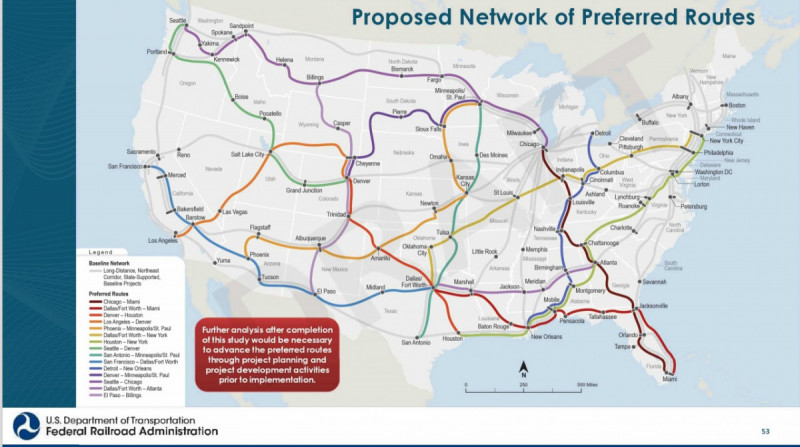
On February 16th, the FRA released a new framework in its ongoing Amtrak Daily Long Distance Study, which focuses on bringing service to new and former routes over 750 miles long. Currently Amtrak has 15 such routes, with six stopping in DC. Apart from the West Coast's Coast Starlight, all of the rest can be reached with only a single transfer from Union Station. On Friday they released a 163-page document detailing their proposed list of preferred routes, a lattice of 15 new routes to be further studied this spring prior to this summer's projected delivery to Congress for approval. Though only one of these new routes would run through DC, at least six, and possibly up to 11 depending on service implementation, would connect to DC with a single transfer. In other words, one day you might be able to reach 47 states from DC without having to switch trains more than once!
Much of this exciting overhaul in the national passenger rail network sits on roughly the same timeline as Union Station's overhaul, which means that by the time that all the paint dries at Union Station, it may be plugged in to scores of new Amtrak routes, several of which have direct connections in DC. Let's take a look at the services that we may one day reach from Union Station.
Northeast Corridor Services
Washington Union Station bookends Amtrak's busiest corridor, a quasi-high speed line that runs north to Boston. Its primary services are the Acela Express, a quasi-high speed business-class service, and the Northeast Regional, a slower service with more stops that runs over 50 trains per day. Infrastructure investments along the corridor plan to increase speeds and capacities, giving room for branch services and new connections. Between Amtrak Connects Us and the CID Plan, several new branches extensions could make new destinations available from DC.
Amtrak Connects Us plan for the Northeast showing new branches off Northeast Corridor services 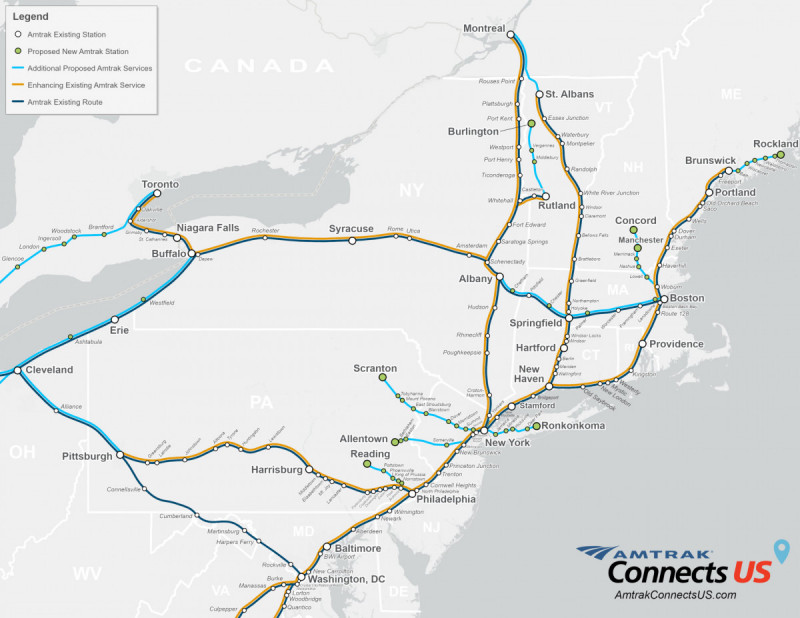
Both programs identify an extension of Amtrak's Vermonter from its current terminus in Saint Albans, Vermont to Montreal. This would make the Quebec metropolis directly connected to DC, whereas today it would require a transfer in New York. This will speed up the journey not only by eliminating the need to for a transfer, but also by running on faster trackage than the Amtrak Adirondack route which runs between New York and Montreal through northeastern New York State.
Though the Northeast Corridor terminates in Boston, Amtrak Connects Us visualizes service to New Hampshire, serving Nashua, Manchester, and Concord. This line was not included in the CID Plan, setting it behind a nearby plan to extend Maine's Downeaster route from its current terminus in Brunswick on to Rockland, along with service increases. The existing Downeaster and proposed New Hampshire services both terminate at Boston North Station, which is currently only connected to the Northeast Corridor's South Station terminus by MBTA subway. Though not widely discussed in any of the federal rail expansion plans, the long-proposed North South Rail Link would connect the two stations, potentially allowing Northeast Corridor trains to through-run to these new destinations and others in Northern New England. This could potentially give passengers at Union Station a one-seat ride to more cities in northern New England, or at least a faster two-seat ride.
Three new branches from New York City may also come to the Northeast Corridor. Service to Allentown, Pennsylvania from the New York area got illustrated in the Amtrak Connects Us plan, though this service may wind up as a New Jersey Transit commuter rail service extension. Another service into Pennsylvania would run on a restored Lackawanna Cutoff route to Scranton, where restoration work will allow trains to cruise at 110 mph along portions of the route and facilitate possible further extensions to Binghamton and points west. As planned, both of these routes would require a transfer at New York. Another proposed branch, however would run from Penn Station through Brooklyn, Queens, and Nassau County terminating in Ronkonkoma as proposed would offer a one seat ride from DC to Long Island. The station in Jamaica Queens would offer a connection to JFK Airport's SkyTrain, meaning passengers at Union Station would have a direct connection to the nation's busiest international air passenger gateway.
The Philadelphia area could offer two more new services, but they would both require a transfer coming from Union Station. The first is a connection to Reading, Pennsylvania. Amtrak Connects Us presents this route to be an Amtrak service running thrice daily from New York through Philadelphia, however SEPTA commuter rail previously operated on this line and could reasonably supplant service on the Philadelphia-Reading section of the corridor in the future as well. In nearby Delaware, a new proposal receiving a grant in the CID Plan would connect either Newark or Wilmington, Delaware to Dover and points south on a route called the Diamond State. As this route remains in very early stages of planning, it remains unclear if Amtrak or regional authority will operate this service, it would connect directly to Amtrak, SEPTA, and the aforementioned MARC train extension. It would return service to the state capital, which has not seen passenger service since 1965, and either Salisbury or Berlin, Maryland. Salisbury, the Delmarva Peninsula's largest metropolitan area, last saw passenger service in 1958.
Points West
The Midwest will see much of Amtrak's expansion, as several new corridors in the Great Lakes states could see new routes that run several times per day. Though no new destinations currently proposed will have a direct connection to DC, shorter and simpler journeys may be possible as new connections and increased service come to the region.
Amtrak Connects Us plan for the Midwest, showing new connections in cities on the Cardinal and Capitol Limited routes which run out of Union Station map by Amtrak.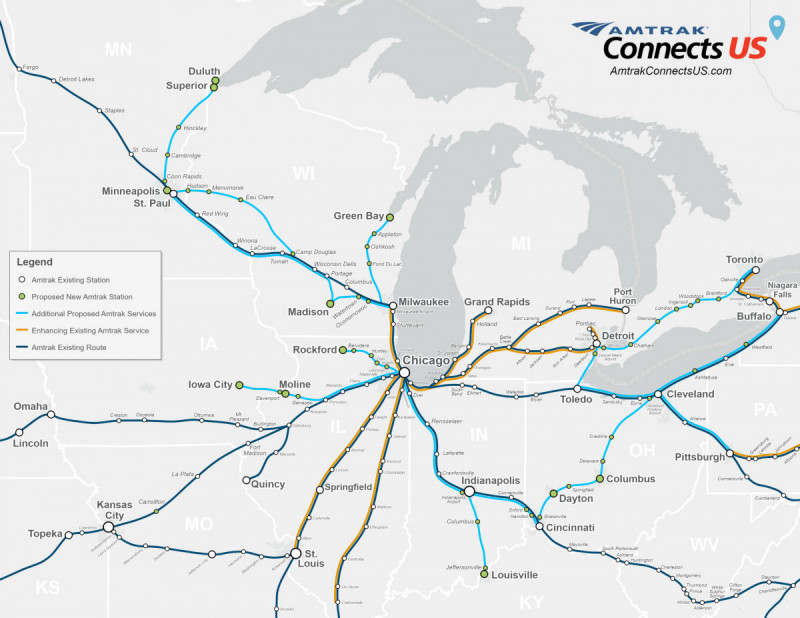
Two Amtrak routes currently run west from DC, the daily Capitol Limited to Chicago via Pittsburgh, Cleveland, and South Bend; and the thrice-weekly Cardinal, which originates in New York and runs to Chicago via DC, West Virginia, Cincinnati, and Indianapolis. Both could see more service in the future. The Capitol Limited Corridor currently has no formal plans to increase service, but since recently the train has reached the limits of its capacity, service improvements will likely come in the future. The Cardinal will very likely see its frequency increased from three times a week to daily after receiving a grant from the CID and recieving support from the Amtrak Daily Long Distance Study.
New services running from Cleveland to Detroit would make the Motor City accessible to Washingtonians with just a transfer in Cleveland or Toledo. Though not currently planned, a direct route from DC to Detroit would become possible once this route gets improved to handle passenger rail. Connections to Columbus will exist in Cleveland and Cincinnati, which can be reached on the Capitol Limited and Cardinal, respectively. Those three cities, plus a few other destinations in Ohio, will be connected by the 3C+D service.
Columbus might also have a connection from Pittsburgh on line from Chicago that would also reconnect Fort Wayne and other cities back into the Amtrak network this route received a CID Plan grant despite getting left out of the Amtrak Connects Us vision. Another connection to Columbus and points west could come from the Amtrak Daily Long Distance Study. The study reviewed the former National Limited train which combined trains from DC and New York into one larger train in Pennsylvania, then continued on to Pittsburgh, Columbus, Indianapolis, Saint Louis, and Kansas City. Instead, the study proposed a similar route from New York to Saint Louis which would then head southwest to Tulsa, Oklahoma City, and Fort Worth. The study does not mention the spur from DC. But if this option became part of the route, it would give Missouri, Oklahoma, and Texas direct connections to DC. If not, riders could simply transfer to this route in Philadelphia.
And if passengers are willing to switch trains from the Cardinal or Capitol Limited, the Long Distance study proposed several new services that would intersect these lines on top of the five south and westbound long distance connections currently availabe in Chicago. A Detroit to New Orleans route would potentially meet the Capitol Limited in Toledo and the Cardinal in Cincinnati. Two new connections would come to Chicago, a southeasterly route to Miami, and a resurrection of the former North Coast Hiawatha towards Montana and the Pacific Northwest. Other new regional connections will likely show up in Chicago, such as connections to Rockford, Peoria, Green Bay, Moline, and Madison, plus additional runs and track upgrades on existing rail corridors terminating in Chicago. By 2040, our sister Union Station in Chicago could have direct connections to 40 states.
Points South
Recent federal investments in railroads have prioritized commencing several new services in the Southeastern states. Virginia and North Carolina routinely shatter ridership records on their state sponsored routes, and thusly have seen federal investment in more routes and faster, more frequent service. A new station in Downtown Atlanta could become a regional hub as well as the southern bookend for a burgeoning Southeast Corridor that could see fast, frequent, electrified service like that on the Northeast Corridor. Since this rapidly growing area has seen its rail network evolve rapidly, it's hard to say what stations will have direct connections to DC in 2040, as we are likely to see adjustments to service patterns. It is reasonable to assume, however, that many of these new services will connect to DC with no more than one transfer.
In Virginia, few new destinations may be in the works, but track improvements and the Long Bridge project will facilitate increased speeds and more service throughout the state. Noteworthy if of little use to riders originating in DC, the Commonwealth Corridor would connect Newport News, Richmond, Charlottesville, and Roanoke along a single corridor. Speaking of Roanoke, the Northeast Regional's twice-daily trains terminating there will soon see an extension to Christianburg, connecting riders to Virginia Tech. This extension will likely continue to grow. This route has enthusiastic local support for an extension all the way to Bristol on the Tennessee border, and the CID Plan granted funds to study the corridor. Perhaps one day it will grow to reach Knoxville or even Nashville.
More concrete prospects an interstate link have come with the S-Line, a stretch of disused track between Petersburg and Raleigh. Restoration of this link will shorten the route and increase travel speeds between Richmond and Raleigh. This connection will ultimately become part of a high(ish) speed corridor between DC and Atlanta, with perhaps a number of different services running on the corridor.
The "S-Line" will create a fast connection between Virginia and North Carolina that will serve as the backbone for a future Southeast Corridor S-Line by North Carolina Department of Transportation (NCDOT).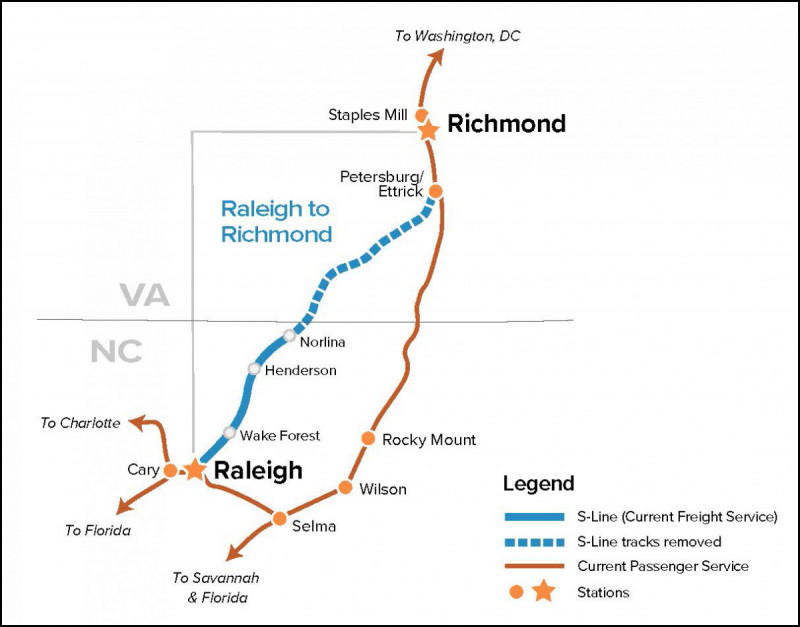
North Carolina may come away as the biggest winner in the Corridor ID Plan. The state shatters ridership numbers at every count, largely do to the success of the Charlotte-Raleigh Piedmont service, supplanted by the Carolinian which runs the entirety of the route and then continues on from Raleigh to New York. New branches proposed recently may wind up as new lines or perhaps extensions of the Piedmont trains. Amtrak Connects Us described a link from Raleigh to Wilmington as a western link from Salisbury to Asheville. The Corridor ID Plan added connections from Raleigh to Fayetteville and Winston-Salem. Including high speed corridors and commuter rail, seven of the 12 corridors the state nominated were awarded grants in December.
The state plans to resubmit the other five proposals when the next call for applications gets announced. North Carolina may set an example for the Southeast with their aggressive and enthusiastic passenger rail expansion. And with the development of fast lines in and out of the state, passengers from DC should receive swift connections to the state in the future.
A new high speed connection betweek Charlotte and Atlanta would provide new service to South Carolina as it potentially forms a new backbone for a Southeast Corridor. Three alternatives exist. The first upgrades the route followed by Amtrak's Crescent through Greenville and Spartanburg. The second would run along I-85. The third and preferred alternative, known as the "Greenfield" route, would stop at Greenville-Spartanburg Airport and Anderson en route to Athens and Atlanta. Notably, this corridor received a grant as a high speed rail route along with other ongoing projects like California High Speed Rail, which plan on running trains at the international standard of 186 to 220mph. Currently, no formal plans exist to connect this corridor to Columbia or Charleston, which currently receive service of various long distance trains running between New York and Florida. But all three metropolitan areas currently have one-seat connections to DC, and those trips will only get faster and more frequent as this wave of investment continues.
In addition to benefitting from the potential high speed rail route, Atlanta could become a regional hub for Amtrak with several proposed connections such as Savannah, Nashville, and Montgomery. If the projects in Virginia and the Carolinas get realized, the trip from DC to Atlanta may compete with travel times on the Northeast Corridor, opening the entire South up to DC rail passengers. When combined with the three no long distance services envisioned for Atlanta, it appears these visions have poised Atlanta to become a major rail hub for the Southeast.
One of those long distance links includes what Amtrak Connects Us and the CID plan refer to as the I-20 corridor, would connect Atlanta to Dallas via Birmingham, Jackson, and Shreveport. This stretch of track parallels an interstate, so it runs flat and straight and has few grade crossings, meaning little work is required for trains to achieve speeds of 110mph on portions of this corridor. The Southern Railway Commission published an economic study proposing to run this route as part of Amtrak's Crescent between New York and New Orleans. The train from New York would split at Meridian, Mississippi, with one section continuing on to New Orleans and the other to Fort Worth.
This would potentially give DC another Direct connection to North Texas through the Deep South. Yet another line proposed in the long distance corridor study would parallel the Crescent running from New York Houston via a slightly different route through Roanoke, Knoxville, Chattanooga, Atlanta, Montgomery, Mobile, and New Orleans. Combined with existing services to Florida, these new trains would make every state in the Southeastern US directly accessible from DC via Amtrak long distance routes.
What's Missing?
These ambitious expansion plans show a great deal of promise for the future of passenger rail. But as wide reaching as these plans are, we still have yet to see proposals for connections to several prominent locations. In many cases, rail infrastructure does not exist. Perhaps some of them were among the 36 projects that applied for but did not receive grants in the Corridor ID Plan. Or perhaps no one has come up with the political will to propose them. In any case, our future platforms at Union Station are not currently projected to host trains to many nearby cities.
Several Maryland towns lack any present or future rail connections. MARC's Camden and Penn Lines split the difference between Annapolis and Columbia, but neither the state capital nor the second largest community in Maryland receive direct service. Annapolis has lacked a rail link since 1950 despite its prominent status and central location. It has not had a direct rail link to DC since 1935. Perhaps by 2040 some kind of commuter rail may run along US-50, but no proposals have surfaced. Industrial tracks branch off toward Columbia from the Camden Line in Savage, but no formal plans exist to bring passenger service to the route. Both areas host major bedroom communities and dump thousands of cars onto Maryland's clogged highways every rush hour.
Tracks exit to Virginia's Shenandoah valley, but no passenger stops exist between Staunton, Virginia and Martinsburg, West Virginia, and no formal plans exist to change that. This area includes destinations such as James Madison University, Shenandoah National Park, Massanutten Resort, Luray Caverns, and the towns of Harrisonburg, Winchester, Front Royal, Woodstock, and Strasburg. Two active rail corridors run through the region, but no one has tried to run a passenger train on them since 1958.
West Virginia faces a slew of social and economic issues in the face of industrial decline and rampant depopulation. The Cardinal improvements should provide an economic boost to the larger towns like Charleston and Huntington, but much of the rest of the state looks to remain isolated from the rail network. Grafton, Clarksburg, and Parkersburg once had Amtrak service along the former Shenandoah route, but that got discontinued in 1981. Other prominent towns sit far off the network, including Morgantown, home of the state's flagship university, and Wheeling, whose metropolitan population sits at almost 150,000.
Though most major areas in surrounding states are or will become accessible by train from Union Station, some gaps remain in the forthcoming plans to increase service coverage. Perhaps by 2040 the passenger rail boom will reach these communities, but we have yet to see any major signs of that.
Decades and Billions of Dollars in the Making
Union Station's big makeover will deliver a world-class train station more befitting a capital city in a wealthy nation. The improved facilities and passenger experience will undoubtedly draw more riders to its platforms, and optimistic forecasts of service expansion imply that they will have many more places to travel. It will provide cleaner (and in many cases faster) transportation alternatives to driving and flying. And Union Station will serve as a proper welcoming gateway for commuters, tourists, and those coming to conduct business in our nation's capital.
The new connections provided will undoubtedly bring social and economic windfall benefitting DC and all those connected to it. These benefits will compound with every additional train, every stop, and every passenger. If all the plans put forward become relaity, every major city in available will be reachable by train from Union Station with no more than one transfer. And as the rest of America hops on board the train, DC will be ahead of the curve not only with a stunning new station, but a cornucopia of destinations to reach from it.

